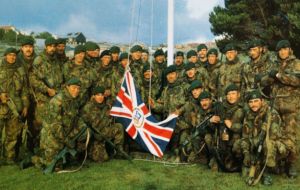MercoPress. South Atlantic News Agency
Falklands: the return of the British flag to Government House in Stanley
 “Major General Moore, the commander of land forces, gave our detachment the honor of replacing the Falkland Islands flag at Government House”
“Major General Moore, the commander of land forces, gave our detachment the honor of replacing the Falkland Islands flag at Government House” The Courier.co.uk has published a revealing piece on the night of the Argentine invasion to the Falklands, 2 April, 1982, the shootout with Argentine troops, the surrender and the return of the British flag to Government House on 14 June at the end of the conflict.
The story is based on an interview with an Angus marine, Sergeant Major Bill Muir, 66, who returned the flag to Government House in Stanley.
Sergeant Major Bill Muir, left 45 Commando in Arbroath to sign up for a year’s tour of duty in the Falklands as part of Naval Party 8,901 and arrived just four days before the Argentines invaded.
The invasion on April 2 1982 took place when both British detachments were on the Islands, but they were still vastly outnumbered by the invading force.
Mr. Muir, who lives in Letham, was in charge of defending Government House, the home of the Falklands’ governors at the edge of the capital Stanley, which was the site of a major battle during the invasion.
He said: “There had been a build-up from the previous week when the Argentines landed a force on South Georgia.
“On April 1 we got the message that an invasion was imminent. We prepared to set up our defenses around the airport and Government House.
“The Argentines invaded in the early hours of the 2nd. We were vastly outnumbered: there were a total of 79 of us across the two detachments and initially the Argentines brought around 700 men ashore.
“They said they had another couple of thousand sitting on ships around the Islands.”
Mr. Muir recalled the firefight which took place under darkness, which led to the British troops becoming surrounded at Government House.
“At 2am we all left our barracks at Moody Brook and the invasion started from about 4am,” he said. “They started coming ashore in the most easterly part of the Island and at 6am from the westerly part of the Island.
“I heard the explosions at the barracks, which were empty. That’s when we knew they were coming from both the east and west. We were tactically surrounded at Government House.
“We were firing off and they were firing back. Rex Hunt, the governor, gave the order to surrender to Major Mike Norman, our commanding officer, at about 9.30am.
“Government House is right on the edge of Stanley and the decision was taken to protect the civilians in the town.
“The Argentine flag was prepared for hoisting on top of Stanley House but the rope snapped in the breeze, which was cheered by the British troops.”
Mr. Muir and the other troops were captured as prisoners of war. After being rounded up, they were allowed to collect their personal kit from the barracks before being flown out at around 7.30pm that evening.
“We were actually treated with respect by the Argentines,” Mr. Muir said.
“We were flown to an airfield in Argentina and then transferred to Montevideo in Uruguay, where we stayed under house arrest for three days until we were picked up.
“I had expected to end up in prison in Argentina but they flew us to Montevideo and left us there. I think it was because it was a good bit of PR for the Argentines.”
Mr. Muir was part of a taskforce attached to 42 Commando which returned to the Islands 48 days later and took part in many battles including Goose Green, Mount Harriet and the taking of Stanley before the end of the war on June 14.
He was given the honor of putting the Falklands flag back at Stanley House.
“Major General Moore, the commander of land forces, gave our detachment the honor of replacing the Falkland Islands flag at Government House as we were the ones there when it was taken down,” said Mr. Muir.
“Looking back on the war, my biggest feeling is one of sadness. A huge number of men died, including some good friends”.




Top Comments
Disclaimer & comment rules-

-

-

Read all commentsFrom the story, it sounds like the 700
Oct 28th, 2014 - 06:09 am 0Argentine soldiers outnumbered the Royal Marines 10 to 1, but still felt they had to kill them in their sleep at the barracks.
10 to 1 or not - the Argentines were not the 'superior' force.
It's worth reading http://www.naval-history.net/NAVAL1982FALKLANDS.htm to get an idea of not only how Naval Party 8901 was outnumbered, but of how British forces were generally outnumbered. Argie reinforcements 300-400 miles away, British reinforcements 8,000 miles away. And how the argies were outclassed and outfought. A particularly sad story for the Gurkhas as the argies ran too fast. I've always wondered why the UK didn't send contingents from the Grenadier Guards, the Coldstream Guards and the Irish Guards. All truly nasty bastards. The Royal Marines, of course, are truly nasty bastards in their own right. So pleased that Sergeant Major Muir got back with 42 Commando in time to teach argies what NOT to do to Royal Marines. I trust that he got considerable pleasure from gunning a number of argies down. Perhaps, being a Commando, he even managed to creep up behind a few and cut their throats. Slowly. Well done, Sergeant Major, in the best traditions of the Corps.
Oct 28th, 2014 - 11:53 am 0There is a rather good drama about the events. It's called 'an ungenllemanly act'
Oct 28th, 2014 - 02:15 pm 0You'll get it on utube,- well worth watching.
Commenting for this story is now closed.
If you have a Facebook account, become a fan and comment on our Facebook Page!